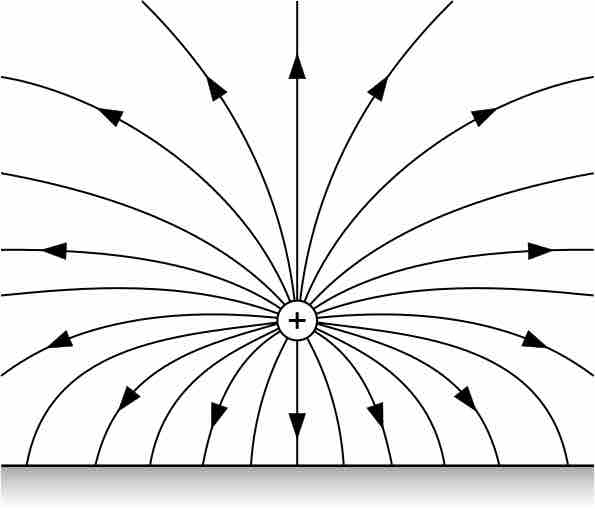An electric field, like other fields (e.g., gravitational or magnetic), is a vector field that surrounds an object . Electric fields are found around electric charges and help determine the direction and magnitude of force the charge exerts on a nearby charged particle. It measures units of force exerted per unit of charge, and its SI units are N/C.

Field Lines Created by a Point Charge
Lines around the positive charge represent the electric field it creates.
Electrical conductors are materials in which internal charges can move freely. Therefore, they can facilitate the flow of charge, or current. When a conductor is placed in the presence of an electric field, it exhibits some interesting properties:
- There is no electric field inside a charged conductor. A charged conductor at electrostatic equilibrium will contain charges only on its outer surface and will have no net electric field within itself. This is because all the charges in such a conductor will symmetrically oppose other charges within the conductor, causing the net result to sum to 0.
- Charged surfaces align themselves perpendicularly relative to electric fields. Provided a conductor is at electrostatic equilibrium, the electric field upon the surface will be aligned perpendicularly with respect to that surface. If there were a nonzero parallel component of the electric field, with respect to any charge on the surface of a conductor, that charge would exert a force and would move. If the conductor is at equilibrium, such a force cannot exist, and therefore the direction of the electric field must be completely perpendicular to the surface.
- Curvature on the surface of a conductor allows for increased charge concentration. Charge will not necessarily distribute itself evenly over the surface of a conductor. If the surface of the conductor is flat, charge will be very evenly distributed. But as the surface becomes more sharply curved, charge can be found more densely packed in areas, even if the conductor is at electrostatic equilibrium. Charges on a curved surface repel one another less strongly than they would on a smooth surface. This is because, based on how the charges are positioned, much of the repulsion the charges exert is in the direction away from the surface of the conductor, not along its surface. And it is harder for charges to be pushed off a surface than along it. Therefore, the repulsion between charges on a curved surface is weaker .

Electrical Charge at a Sharp Point of a Conductor
Repulsive forces towards the more sharply curved surface on the right aim more outward than along the surface of the conductor.